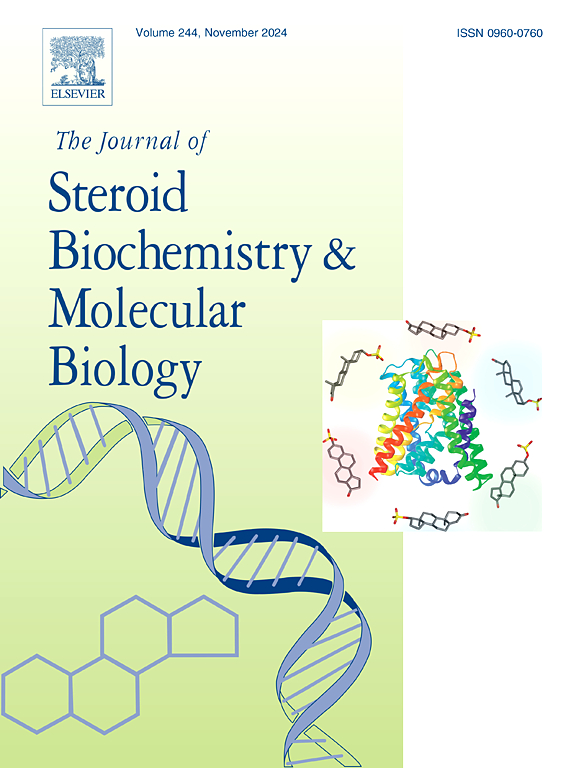Interplay of calcium, vitamin D, and parathormone in the milieu of infections and immunity: Reassessed in the context of COVID-19
IF 2.7
2区 生物学
Q3 BIOCHEMISTRY & MOLECULAR BIOLOGY
Journal of Steroid Biochemistry and Molecular Biology
Pub Date : 2024-10-09
DOI:10.1016/j.jsbmb.2024.106624
引用次数: 0
Abstract
Severe acute respiratory syndrome coronavirus 2 (SARS-CoV-2) is recognized for inducing severe respiratory symptoms like cough, and shortness of breathing. Although symptom severity varies, some individuals remain asymptomatic. This virus has sparked a global pandemic, imposing a substantial rate of mortality or morbidity, with extended periods of illness reported. People with underlying medical issues and the elderly are more likely to experience adverse results. The virus's frequent mutations pose challenges for medical professionals, necessitating adaptable therapeutic and preventive strategies. Vitamin D, a versatile regulatory molecule, not only influences physiological processes such as serum calcium regulation but also exhibits immunomodulatory functions. Calcium ions play a crucial role as secondary signal transduction molecules, impacting diverse cellular functions and maintaining homeostasis through ion channel regulation. Parathormone, another key regulator of serum calcium, often acts antagonistically to vitamin D. This review delves into the interplay of vitamin D, calcium, and parathormone, exploring their possible influence on the progression of COVID-19. The intricate signaling involving these elements contributes to adverse prognosis, emphasizing the need for comprehensive understanding. Monitoring and controlling these physiological factors and associated pathways have shown the potential to alter disease outcomes, underscoring the importance of a holistic approach.
钙、维生素 D 和副激素在感染和免疫环境中的相互作用:根据 COVID-19 重新评估。
严重急性呼吸系统综合征冠状病毒 2(SARS-CoV-2)被认为会引起严重的呼吸道症状,如咳嗽和呼吸急促。虽然症状轻重不一,但有些人仍无症状。这种病毒已在全球范围内引发大流行,死亡率或发病率很高,有报告称患病时间较长。有潜在疾病的人和老年人更容易出现不良后果。病毒的频繁变异给医学专家带来了挑战,需要有适应性强的治疗和预防策略。维生素 D 是一种多功能调节分子,不仅影响血清钙调节等生理过程,还具有免疫调节功能。钙离子作为次级信号转导分子发挥着至关重要的作用,影响着多种细胞功能,并通过离子通道调节维持体内平衡。本综述深入探讨了维生素 D、钙离子和副钙离子之间的相互作用,探讨了它们对 COVID-19 进展可能产生的影响。涉及这些因素的信号转导错综复杂,导致不良预后,因此需要全面了解这些因素。对这些生理因素和相关途径的监测和控制已显示出改变疾病预后的潜力,强调了综合方法的重要性。
本文章由计算机程序翻译,如有差异,请以英文原文为准。
求助全文
约1分钟内获得全文
求助全文
来源期刊
CiteScore
8.60
自引率
2.40%
发文量
113
审稿时长
46 days
期刊介绍:
The Journal of Steroid Biochemistry and Molecular Biology is devoted to new experimental and theoretical developments in areas related to steroids including vitamin D, lipids and their metabolomics. The Journal publishes a variety of contributions, including original articles, general and focused reviews, and rapid communications (brief articles of particular interest and clear novelty). Selected cutting-edge topics will be addressed in Special Issues managed by Guest Editors. Special Issues will contain both commissioned reviews and original research papers to provide comprehensive coverage of specific topics, and all submissions will undergo rigorous peer-review prior to publication.

 求助内容:
求助内容: 应助结果提醒方式:
应助结果提醒方式:


